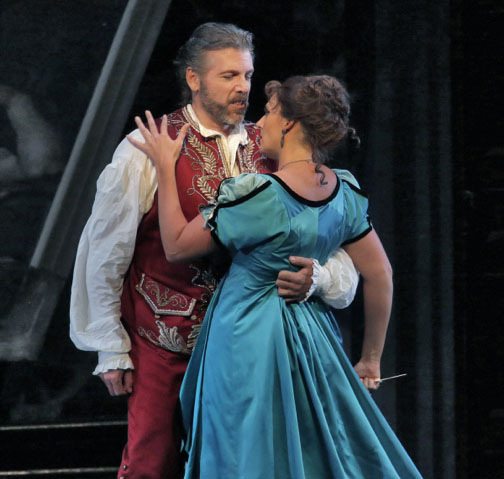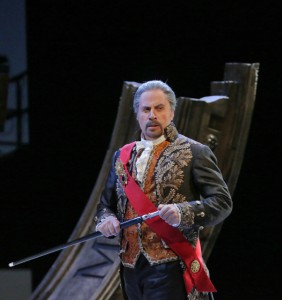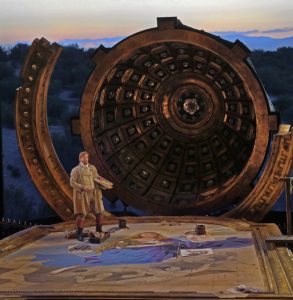Thomas Hampson takes over as Scarpia in Santa Fe Opera “Tosca”
Now playing in summer festival repertory.
Review by David Gregson of August 8 performance — an plus update for the cast change in the August 11 performance.
As had been planned from the beginning of the season, famous American baritone Thomas Hampson took over the role of Scarpia Saturday night in Santa Fe Opera’s production of “Tosca.” Dramatically, Hampson was a great improvement over basso Raymond Aceto who had been performing the role since the production was first presented on June 29. Vocally — well, it’s a toss up.
Looking extremely slim, tall and handsome and sporting a dark beard, Hampson commanded the stage as Puccini’s infamous villain, one of the nastier ones in all opera. He notably rejected some of stage director Stephen Barlow’s more physically erotic stage directions. Unlike Aceto, Hampson did not give La Tosca an intimate TSA style pat down, nor did he pin the diva to the floor as if about to rape her before God and creation: after all, Spoletta and Company are running in and out of the office.
In the Act One “Te Deum,” Hampson was slightly underpowered for the scene’s vocal demands, and elsewhere he did not produce the ideally black vocal quality that makes for the most exciting sort of Scarpia. I confess to having predicted this in my own mind. Although I regard Hampson as a great artist, I have never thought this sort of role would be good for him. Am I unfair to feel this way? Perhaps the sound of Tito Gobbi is lodged forever in mind. His was the first Scarpia I ever heard, way back in high school.
What follows is my review of “Tosca” sans Hampson. Looking it over today, I can see I failed to mention the really excellent performance of the fugitive who opens the entire opera and gives impetus to the whole story. This was Cesare Angelotti as sung by impressive sounding Santa Fe apprentice baritone Zachary Nelson, for whom I predict a great career. I also enjoyed hammy bass-baritone Dale Travis who extracted virtually every comic possibility in the role of the Sacristin, even singing several times while scarfing down bits of food stolen from Cavardossi’s luncheon basket. I also thought tenor Dennis Peterson was excellent as Scarpia’s evil minion, Spoletta.
A second visit to this production also gave me a different impression of soprano Amanda Echalaz: she seemed much more The Diva in Act One than on first hearing. And as for the quasi-expressionist sets that gave us tilted views of almost everything, I actually enjoyed seeing the brilliant lighting of the colorful inner skin of the “cupcake-presser” church dome in Act One. (Lighting was by Duane Schuler.) Nothing, however, can convince me that Cavaradossi would be painting his Madonna on the church floor. I noticed Hampson took care not to step on her freshly painted face.

Thomas Hampson as Scarpia -- with lighting on the inside of the "cupcake dome". The "Te Deum" scene. Photo by Ken Howard.
++++The Review++++
One likes to come to Santa Fe Opera — or at least I do — for the unusual items: things like this season’s “King Roger” and “Maometto II,” and I would even put “Arabella” on the list. Perhaps, although more marginally offbeat, “The Pearl Fishers.”
But “Tosca”? That sounds like the annual “pop” item designed to sell lots of tickets to people who do not even care who’s singing. And, really, what jaded opera veteran wants to hear “Tosca” yet again (even if it is a masterpiece!) when the singers are relatively unknown and you have seen virtually every great diva on earth perform the title role over a life span of many years? This is not even taking into consideration tenors and baritones who have thrilled you as Cavaradossi and Scarpia.
So, it was a delightful surprise to encounter a genuinely exciting Floria Tosca, a very promising Mario Cavaradossi, and an imposing Scarpia singing in virtual silhouette before the desert sunsets over the distant Jemez Mountains.
South African soprano Amanda Echalaz is gifted with a large, sumptuous voice (she has already sung Salome at La Monnaie) and she can scale her vocal instrument from the girlish to the mature woman: she already has Cio-Cio San and Tatyana in her repertoire. Her first-act Tosca is girlish and alluring. She enters all in white, wearing a white veil — and instead of impersonating the oversized insanely jealous diva, she portrays a playful, charming young woman who toys with the idea of jealousy, smiling all the time. She knows it’s a game and a bit of joke. This makes her lovable from the get-go, and we feel her agony when Scarpia brings her latent and authentic jealousy to the surface.
In the second act, Echalaz gradually rises to a rage we can really believe in, and she performs her murder of Scarpia with tension-charged balletic movements and some wonderfully powerful singing. In short, she is going to make her mark with this role wherever she goes. She would have made a greater impression in the last act, by the way, had the staging (more on that to follow) been less inept.
Talented American tenor Brian Jadge, a handsome man (despite being a bit heavier than I had expected), has so much voice he can’t help showing it off, sometime to the detriment of the role. He does not need to sing so loudly so often: the voice spreads and loses some of its natural beauty. From instinct and training, he knows his way around a stage, and he can be perfectly charming — although some people complained to me that he did not seem to have “chemistry” with his leading lady. My impression of him was that he is a first-rate talent needing a little more discipline. I saw the great mezzo Susan Graham give a master class here in Santa Fe last Tuesday, and she was able to draw markedly improved performances out of her four apprentice students in the space of a mere 30 minutes each. Jadge might rocket to the top of his craft if he too spent 30 minutes heeding Graham’s brand of advice. As good as he is, Jadge is still in the promising category.
It will be interesting to see what Thomas Hampson does with the role of Scarpia when he takes over from American basso Raymond Aceto this coming Saturday. Aceto is not among the nastier, snarlier Scarpias I have ever seen, but he is a striking presence, nonetheless. The stage director, Stephen Barlow, requires Aceto to virtually rape Tosca on stage, and this Aceto does as if it were second nature to him. Scarpia clearly behaves this way on a regular basis, so Aceto conveys the villainy as instinctive and as natural as breathing. The voice is fine, if not among my favorites: quality-of-voice judgments are terribly subjective.
The sets of scenic designer Yannis Thavoris are a literally topsy-turvy representation of Rome, and any hint of the Castel Saint’Angelo from which our heroine famously leaps to her death is missing. She leaps, handcuffed (a novelty, to be sure) off of something somewhere with tilted church domes visible in the distance.
The venue where Cavaradossi is painting his Madonna (on the floor, by the way, as if he were Jackson Pollock) is supposed to be the church of Sant’Andrea della Valle. This looks like some giant cooking utensil that presses out cupcakes; and we see Santa Fe’s landscapes stretching away at the rear.
Scarpia’s apartment in the Palazzo Farnese is dominated by a huge fresco in need of repair. Tosca picks up the fruit knife to murder Scarpia before the usual time indicated in the libretto, but she drops it and has to go searching for it again when the hour of Scarpia’s doom is struck. Tosca covers the corpse with a coat and then hauls it into another room, so Puccini’s music for the placement of candles and the cross takes on new illustrative meanings.
And, in the very height of absurdity, the Act Three shepherd boy becomes a janitor cleaning up Scarpia’s bloodied room with broom. Stage directors know so much better than the composer these days. Hey, this is a pretty scene usually: dawn in Rome, church bells ringing, and the shepherd boy singing as he guides his flocks into the new day.
Conductor Frédéric Chaslin led the excellent orchestra in an exciting and nuanced performance of the score.
Oh, singing “Vissi d’arte” while lying on the floor has become such a cliché that Barlow permits Amanda Echalaz to stand and deliver.
And deliver she did.
Cesare Angelotti – Zachary Nelson
Floria Tosca – Amanda Echalaz
A Sacristan – Dale Travis
Mario Cavaradossi – Brian Jagde
Scarpia: June 29 – Aug. 8 – Raymond Aceto
Scarpia: August 11 – 24 – Thomas Hampson
Spoletta – Dean Peterson
Conductor – Frédéric Chaslin
Director – Stephen Barlow
Scenic Designer – Yannis Thavoris
Costume Designer – Yannis Thavoris
Lighting Designer – Duane Schuler
For complete schedule and ticket information, please visit http://www.santafeopera.org/index.aspx




